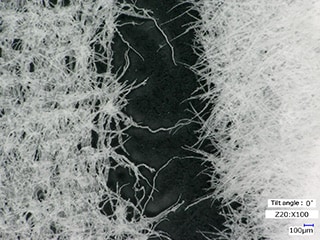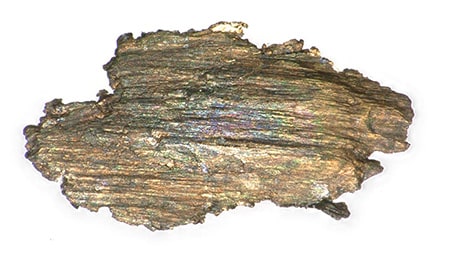Foreign Particle Observation and Analysis
The contamination of food, medicine, and their packaging with foreign particles is a serious problem in the market. Quality assurance demands quick identification and analysis of foreign particles so the root cause can be determined and steps can be taken to prevent future occurrences.
This section introduces foreign particle analysis methods and application examples of KEYENCE's latest 4K digital microscope, which solves problems that arise when using conventional microscopes.

- Problems Caused by Contamination With Foreign Particles and Increasing Response Speed
- Foreign Particle Analysis Methods and Conventional Problems
- Application Examples of Fast, Accurate Foreign Particle Analysis Using KEYENCE's Digital Microscope
- Observation of three-dimensional foreign particles
- Observation of foreign particles contaminating a multi-layer film
- Observation of insects
- Low-magnification/high-magnification observation of fibres
- Observation of hair cuticles
- Foreign particle analysis of cotton swabs
- High-definition observation of metal fragments
- Observation of small insects adhered to a food surface
- Observation of foreign particles contaminating a transparent film
- Observation of mould on the surface of food
- A Multi-Function Microscope That Makes Foreign Particle Analysis More Advanced and Efficient
Problems Caused by Contamination With Foreign Particles and Increasing Response Speed
These days, consumers spread information instantly over social networking services. As such, the contamination of food, medicine, and similar products with foreign particles has been distinguished as a serious problem. Consequently, there has been a rise in consumer awareness and concern regarding the safety of food and medicine.
Also, food served regularly to many people at schools, hospitals, and similar facilities has especially severe requirements for safety and quality assurance. When a problem occurs, it is necessary to quickly clarify the location responsible for the problem, to use analysis to investigate the cause of the occurrence, and to implement countermeasures against reoccurrences of the problem.
In many cases, the analysis of foreign particles is outsourced to 3rd party companies. However, speed is of the utmost importance when responding to contamination, so there is an increasing trend of companies having their own analysis equipment in the food and medicine industries.
Foreign Particle Analysis Methods and Conventional Problems
Most often, foreign particles contaminating a product have a composition that differs from that of the product itself, so the common method of foreign particle analysis is composition analysis. However, consider the case of an insect contaminating a product that contains protein. It may not be possible to designate or identify this insect as a foreign particle just with composition analysis.
Therefore, foreign particle observation and analysis by way of an appearance inspection using a microscope is just as important as composition analysis. In other words, ensuring the accuracy of foreign particle analysis requires not just a composition analysis device but also an optical microscope that is capable of observing a microscopic outer appearance with high accuracy.
However, foreign particle observation and analysis using conventional optical microscopes poses the risk of overlooking foreign particles due to the following problems:
- The image only focuses on a part of the target due to the foreign particle and product being three dimensional.
- Foreign particles on reflective metals or plastic packaging films are difficult to observe due to reflected light.
Application Examples of Fast, Accurate Foreign Particle Analysis Using KEYENCE's Digital Microscope
KEYENCE has repeatedly improved its digital microscopes over the past 20 years using feedback from our customers. The result of this process is the VHX Series 4K Digital Microscope. Its high-resolution HR lens, 4K CMOS, proprietary observation system, and advanced image processing not only enable observation of microscopic shapes, but also allow for high-accuracy 2D and 3D measurements. It solves various problems that conventional optical microscopes encounter, while also enabling more advanced analysis.
This section introduces application examples of foreign particle analysis using the VHX Series.
Observation of three-dimensional foreign particles
The VHX Series 4K Digital Microscope has realised a depth of field that is approximately 20 times deeper than that of conventional microscopes. The real-time depth composition function can be used to quickly obtain high-definition 4K images in which the entire target is fully focused, even in the case of three-dimensional targets. Obtaining such images makes observation accurate and improves the efficiency of work, regardless of the shapes of the foreign particles.


Observation of foreign particles contaminating a multi-layer film
In this example, foreign particles contaminating multi-layer films, which are used in the packaging of food and medicine, are observed. Conventionally, it was not possible to determine the shape of a foreign particle because ring-shaped reflections occurred at the location where the foreign particle causes a bump in the film.
With the VHX Series 4K Digital Microscope, the ring-reflection removal function—which instantaneously obtains multiple images with varying ring illumination lighting directions at the push of a button—can eliminate these ring-shaped reflections. Eliminating ring-shaped reflections enables clear observation of foreign particle shapes by preventing the effect of reflections from the film surface.


Observation of insects
Among all foreign particles, insects have extremely complex three-dimensional shapes and often have low colour contrast.
With conventional microscopes, time-consuming lighting adjustments must be made in order to properly observe the target.
The VHX Series 4K Digital Microscope is equipped with a multi-lighting function that quickly obtains multiple images with various types of lighting from all directions at the push of a button. This function enables users to simply select the image that is appropriate for observation from among all the obtained images. This function eliminates the time and effort that was previously spent on adjusting lighting conditions.
Image data containing the entire range of lighting conditions is automatically saved, and past images can be opened and observed under different conditions. This function increases throughput and allows for more samples to be analysed.


Low-magnification/high-magnification observation of fibres
The high-resolution HR lens and motorised revolver of the VHX Series 4K Digital Microscope enable a seamless zoom function that automatically switches between lenses according to the magnification. This seamless zoom eliminates the time and effort that were required to replace lenses and enables magnified observation from 20x to 6000x with intuitive operations.
The cutting-edge optical system and 4K CMOS enable clear observation of fibre structures and foreign particles, even at high magnifications.


Observation of hair cuticles
High-resolution 4K images can even be obtained at high magnifications. Clear observation of cuticle shapes is even possible with hair samples. This clear observation makes it possible to quickly identify whether contaminating hair belongs to a human or an animal or is actually a fibre from a piece of clothes.

Foreign particle analysis of cotton swabs
With the VHX Series 4K Digital Microscope, foreign particles can be clearly observed and analysed even in the case of cotton swabs and other such targets having three-dimensional structures.
Due to the limitations of the depth of field of conventional microscopes, it was only possible to bring a part of a three-dimensional target into focus at a time. Hence, it sometimes was difficult to observe microscopic foreign particles due to insufficient resolution.
The VHX Series can obtain high-definition images of the structure of foreign particles present in three-dimensional cotton swabs with the entire target fully focused. These images enable smooth foreign particle analysis in which nothing is overlooked.


High-definition observation of metal fragments
Metal fragments with uneven surfaces are traditionally difficult to focus and identify foreign particles.
The VHX Series 4K Digital Microscope large depth of field enables the entire fragment to be brought into focus, enabling simple identification of foreign particles.

Observation of small insects adhered to a food surface
Releasing food in which foreign particles have adhered to is a serious problem that harms the safety and reliability of the product.
The VHX Series 4K Digital Microscope can be used to quickly perform high-magnification inspection of food surfaces to identify any contamination.

Observation of foreign particles contaminating a transparent film
With conventional microscopes, observing foreign particles in plastic films is especially difficult, due to the high-degree of transparency.
The VHX Series 4K Digital Microscope uses backlighting to highlight foreign particles contaminating a transparent film.

Observation of mould on the surface of food
With conventional microscopes, foreign particles are sometimes overlooked because it is only possible to bring a part of the sample into focus at a time. Targets with curved surfaces are particularly hard to inspect.
The deep depth of the field of the VHX Series enables it to perform inspection even on curved surfaces, such as checking for mould on the surface of a donut. The deep depth of field ensures no foreign particles are overlooked.

A Multi-Function Microscope That Makes Foreign Particle Analysis More Advanced and Efficient
The VHX Series high-definition 4K Digital Microscope is also equipped with various other functions to aid in identifying foreign particles, such as a free-angle tilt stand, 2D and 3D measurement capabilities, and automatic particle identification and counting. Furthermore, it is even possible to output reports using observation images and measured values with user-specified templates. A single VHX Series microscope is all that is needed to seamlessly and quickly complete an entire series of work operations.
For additional product info or inquiries, click the buttons below.


